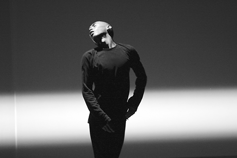New Japanese dance warns against the speed of progress
Self-annihilation ran rampant in two new works at Dance Theater Workshop as Japanese choreographers Hiroaki Umeda and Yoko Higashino used dance and, occasionally, robots to explore the destruction of society. In both works, rhythmic movement was presented as emblematic of mechanical thought or ideals. Both pieces referenced Japan as their point of departure—while still managing to convey a feeling of being conspicuously part of the Chelsea dance scene.
The evening opened with Umeda’s “while going to a condition,” a mood piece if you will, which involved the choreographer’s transition from somber statue to virtual-krumper. In “condition,” Umeda thawed himself gradually, as a backdrop of blue light shifted and expanded in pattern-variation form, and the music follows suit. As Umeda gradually released and expanded his movement with the beat of his surroundings, he slipped into a more techno style of dance, alchemizing the complexity of machinery with the smooth rhythm of progress. And as his movement became darker and deeper, the shadow copies of him, cast by the lighting, appeared to close in on him—fast—from the sides of the stage to the balls of his feet.
The dance managed to meld music, lighting, and movement into dervish-like speed before it flat-lined like a heart attack or, more aptly, a blown-out TV. This “blowing out” could be construed as the result of human advancement, and especially as the result of the development of Japanese technology, as underscored by the expanding patterns of lighting in the background. But whether one chose to see it as a commentary on the pace of technology, or merely as the convergence of different aspects of one’s personality to a single dot, “while going to a condition” suggested urgency and bore as much relevance in its broad perspective as it did in its clarity of purpose.
While Hiroaki Umeda allowed the audience the right of interpretation, Yoko Higashino was more concerned with aiming for the head and making it spin. In “ALARM! zero hour edition,” Higashino employed robots, air controllers, and women in various states of undress to constitute what she sees as the anti-Japan. Much like George Orwell’s “1984,” the audience was presented with a world entirely unlike the one they live in, but one that through its differences illuminates the absurd disparities of real-life.
Higashino’s dancers moved beautifully, but with little order and less sense. They stepped into mechanical loops of motion as they pranced around, occasionally directed by a pair of air traffic controllers who bore a suspicious resemblance to the Spartan Cheerleaders on “Saturday Night Live.” As women tore off their clothes smiling, or burst into flowers, the audience might be inclined to ask why. The answer rested in the only sensible character in the piece, the non-human one. A robot dressed in a blond wig and sunglasses, mirroring the dancer-choreographer’s own garb, turned in lopsided ovals in a small corner of the stage throughout the show. The invariable robot provided order and a basis of comparison for all the silly humans in the show.
In an episode of transference, Higashino has passed the buck to a new generation of choreographer, a mechanical one. The final image of “ALARM” was a woman wearing a kimono tearing off her beautiful clothes before the robot and smiling—the epitaph of tradition destroyed for the sake of progress.
gaycitynews.com


































